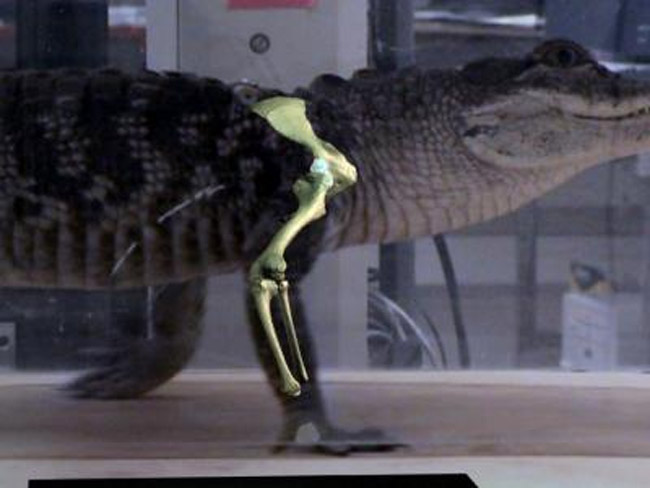New X-ray Videos Show Animal Skeletons in Motion

Scientists are filming alligators as they trot along treadmills and pigeons on the fly in wind tunnels. But rather than a view of flesh and muscles, a new 3-D video technique peeks beneath the skin to show skeletons on the move.
“This will be like having X-ray vision—you'll be able to see through skin and muscle and watch a skeleton move in 3-D," said lead scientist Elizabeth Brainerd of Brown University. “Imagine animated X-ray movies of flying bats or flexing knees."
The final movie maker is still in the design phase, but scaled down versions of it are already proving a success.
- Video: X-ray Movie of a Pig Walking
Two Brown University scientists, Stephen Gatesy and David Baier, are using this approach to understand how the biomechanics of flight evolved. To trace flight back in time, Baier has made skeletal movies of alligators—the closest living relatives of birds—as they walked along a moving treadmill.
Then at Harvard University, Baier and his colleagues had to familiarize the crocodilians with their new exercise platforms for about two weeks. Some treadmill trekkers were more cooperative than others, the researchers found [image].
“Some of them really took to it, and others just didn’t want to walk," Baier told LiveScience. "They would just lie down until you stopped the treadmill. Some would try to jump and turn around and go the other way.”
In a recent study, Baier discovered a flight-helping ligament that transformed as winged birds evolved. Now, he and his colleague Ken Dial of the University of Montana are gearing up to study birds as they toddle up steep inclines while flapping their wings. By comparing the skeletal movies from the walking birds with those in flight, the scientists expect tease out other key features needed for flight.
Sign up for the Live Science daily newsletter now
Get the world’s most fascinating discoveries delivered straight to your inbox.
The technique will also breathe life into fossil bones from extinct animals like theropod dinosaurs. Three-dimensional images of the brittle bones can be fitted with moving skeletons from modern-day relatives.
“The CTX technique will align those 3-D bones frame-by-frame to match what we’re seeing in the 2-D X-ray movie,” Brainerd said in a telephone interview. “So we need to understand precisely how the skeleton of living animals moves so we can try to reconstruct how the skeletons of extinct animals might have moved.”
Some other blockbuster applications:
- Measuring the forces applied to each joint as a person runs or a frog jumps.
- Testing new theories of biomechanics, such as muscle-tendon interactions.
- Studying the evolution of joints, from the cartilaginous joints in most mammals to the “more advanced” joints in humans, which are bonier.
- Planning orthopedic surgeries and comparing the effectiveness of different approaches.
- Creating better treatments for shoulder, wrist, knee and back injuries.
Called CTX, the final system will be able to whip out 1,000 frames per second of a moving 3-D skeleton. The system will be designed and built with a $1.8-million grant from the W.M. Keck Foundation, and is expected to be complete by 2010.
Other Cool Videos
More to Explore
- Images: The World's Biggest Beasts
- How Many Muscles Does a Human Have?
- Images: Dinosaur Art
Jeanna Bryner is managing editor of Scientific American. Previously she was editor in chief of Live Science and, prior to that, an editor at Scholastic's Science World magazine. Bryner has an English degree from Salisbury University, a master's degree in biogeochemistry and environmental sciences from the University of Maryland and a graduate science journalism degree from New York University. She has worked as a biologist in Florida, where she monitored wetlands and did field surveys for endangered species, including the gorgeous Florida Scrub Jay. She also received an ocean sciences journalism fellowship from the Woods Hole Oceanographic Institution. She is a firm believer that science is for everyone and that just about everything can be viewed through the lens of science.









